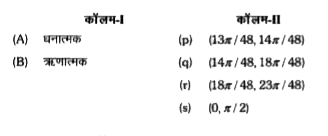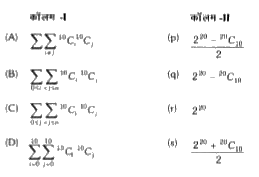यदि (1, 2, -1) तथा (-1, 0, 1) को मिलाने वाली रेखा हो, तो (l,m,n) का मान होगा
(-1,0,1)
(1,1,-1)
(1,2-1)
(0,1,0)
The correct Answer is:B
Step by step video, text & image solution for यदि (1, 2, -1) तथा (-1, 0, 1) को मिलाने वाली रेखा (x-1)/(l)=(y-2)/(m)=(z+1)/(n) हो, तो (l,m,n) का मान होगा by Maths experts to help you in doubts & scoring excellent marks in Class 12 exams.
Topper's Solved these Questions
- BOOK - ERRORLESS HINDICHAPTER - त्रिविमीय निर्देशांक ज्यामिति EXERCISE - MULTIPLE CHOICE QUESTIONS (समतल)46videos
त्रिविमीय निर्देशांक ज्यामिति
- BOOK - ERRORLESS HINDICHAPTER - त्रिविमीय निर्देशांक ज्यामिति EXERCISE - MULTIPLE CHOICE QUESTIONS (रेखा व समतल)31videos
त्रिविमीय निर्देशांक ज्यामिति
- BOOK - ERRORLESS HINDICHAPTER - त्रिविमीय निर्देशांक ज्यामिति EXERCISE - MULTIPLE CHOICE QUESTIONS34videos
त्रिविमीय निर्देशांक ज्यामिति
- BOOK - ERRORLESS HINDICHAPTER - त्रिकोणमितीय अनुपात, फलन एवं सर्वसमिकायेEXERCISE - JEE Advanced (Matrix Match type questions)5videos
त्रिकोणमितीय अनुपात, फलन एवं सर्वसमिकाये
- BOOK - ERRORLESS HINDICHAPTER - द्विपद प्रमेय तथा गणितीय आगमन EXERCISE - JEE Advanced (Matrix Math type questions)5videos
द्विपद प्रमेय तथा गणितीय आगमन
Similar Questions
यदि बिन्दु P(1,-2,1) से समतल x+2y−2z=α , जहाँ a>0 की दूरी 5 है तो बिन्दु P से समतल पर डाले गए अभिलम्ब का पाद (foot) निम्न है:
04:14View Solutionबिन्दुओ (2,-3,1) तथा (3-4,5) को मिलाने वाली रेखा समतल 2x+y+z=7 को जिस बिन्दु पर काटती है, वह बिन्दु है
02:13View Solutionयदि बिन्दु (-1,2,-3),(4,a,1) और (b,8,5) समरेखीय हैं, तब a और b क्रमशः बराबर हैं
02:43View Solutionनिम्नलिखित कॉलम I को कॉलम II से मिलाये
 03:56View Solution
03:56View Solutionनिम्नलिखित कॉलम I को कॉलम II से मिलाये
 02:59View Solution
02:59View SolutionFind the acute angle between the lines x−1l=y+1m=1nand=x+1m=y−3n=z−1lwherel>m>n,andl,m,n are the roots of the cubic equation x3+x2−4x=4.
03:38View SolutionIf (x-1)/(l)=(y-2)/(m)=(z+1)/(n) is the equation of the line through (1,2,-1) and (-1,0,1) then (l,m,n)
02:29View SolutionFrom the following sets quantum number state which are possible. Explain why the other are not permitted ?
a. n=0,l=0,m=0,s=+1/2
b. n=1,l=0,m=0,s=−1/2
c. n=1,l=1,m=0,s=+1/2
d. n=1,l=0,m=+1,s=+1/2
e. n=0,l=1,m=−1,s=−1/2
f. n=2,l=2,m=0,s=−1/2
g. n=2,l=1,m=0,s=−1/202:40View SolutionIf L(m,n)=∫10tm(1+t)n,dt, then prove that
L(m,n)=2nm+1−nm+1L(m+1,n−1)02:56View Solutionयदि x−1l=y−2m+z+1n, उस रेखा का समीकरण है जो (1,2,−1) तथा (-1,0,1) से होकर जाती है, तो (l,m,n) क्या होगा?
10:58View Solutionयदि 1,m,n वास्तविक हो व् l≠m, तो समीकरण (l−m)x2−5(l+m)x−2(l−m)=0 के मूल होगा।
03:10View Solutionयदि 1+1+22+1+2+33+ …n पदों तक का योग S हो , तो S का मान होगा।
02:48View SolutionIf L(m,n)=∫10tm(1+t)n,dt, then prove that
L(m,n)=2nm+1−nm+1L(m+1,n−1)06:41View SolutionIf (x-1)/l=(y-2)/m=(z+1)/n is the equation of the line through (1,2,-1) and (-1,0,1) , then (l,m,n)
03:21View SolutionGivne lines are x−1l=y+1m=zn and x+1m
=y−3n=z−1l where l>m>n l,m, n are roots of the equation x3+x2−4x=4 then the angle between them is ........02:33View SolutionDifferential coefficient of (xl+mm−n)1n−1.(xm+nn−1)1l−m.(xn+1l−m)1m−n w.r.t x is
03:19View Solution

